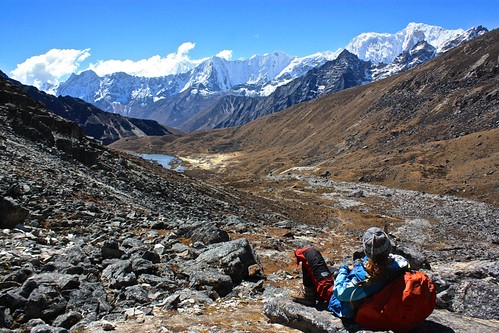Trekking to the base camp or through the high passes of the world's highest mountain doesn't have to be expensive--or difficult. We spent 17 days on the trail and here's how we made the most of our time and wallet.
If you need a porter-guide, find him in Lukla
Unless you have a personal recommendation, don't book ahead and definitely don't use an agent as he/she takes an incredibly high cut off what you pay. Porters wait outside the Lukla airport so run some makeshift interviews, agree on a price, and set off in comfort. Budget around 1000NPR per day, slightly more if you're doing the high passes. (We only ended up using a porter for three of the 17 days, so it is possible to do the passes without one. Just know that it's not easy.)
Showers are for cleanliness, not for warmth
Even a piping hot shower won't warm you up in a non-heated room, so plan accordingly. Also, showers are expensive. Baby wipes on the other hand are cheap and they won't make you freeze.
Always ask for a free room
Yes, you read correctly! You can get most of your rooms for free if you bargain a bit and tell the lodge owner that you'll eat dinner and breakfast there. For the names of the lodges where we stayed, check out our trekking diary.
Be flexible
Allow time for headaches, backaches, laziness, etc. The worst thing you can do is allow just enough time to complete your route. Doing so means you'll push yourself too fast and increases the likelihood of you getting sick.
Get off the EBC track
Even if you can't do all three of the passes, try to add at least one detour to your out and back trek. Not only will it give you the chance to explore some of the interesting valleys, but you'll also escape the crowds.

Have your Kathmandu hotel book your flights
The price is fixed by the government at US$162pp one way, so save yourself the hassle and have your hotel or guesthouse deal with the tickets. Early morning flights have the best chance of flying.
Take care of your TIMS and trekking permits in Kathmandu
The Tourist Service Center is easily accessible from Thamel and the process is pretty fast and easy as long as you bring 5000NPR, two passport photos, and your itinerary. They have free WiFi in case you forget any of the details.
Don't start your trek in mid October
We saw more people going up the trail on October 10th than we did on all of our previous days combined. Starting the trek in late September let us experience the quieter side of the Himalayas, although it did come with some snowstorms.
Get early starts on the trail
As much as it sucks to get up at 4:30am, it's often your best chance of seeing the views and avoiding the clouds. That said, consider whether you really need to be on top of the mountain for sunrise. We found that halfway up worked just as well, and it meant that we did half the hike in the sun.
Purify your own water
We used Aquamira drops to both purify and enhance the taste of our water. Not only does purifying save you tons of money, but it's a lot better for the environment.
Pack smart
Just because you have you porter doesn't mean you need to bring 20kg of gear. One pair of clean and warm clothes for night, a sleeping bag, one change of trekking clothes, and some snacks/protein bars is all you need. If you're going to higher altitudes like we did, you'll need warmer clothes, but the good news is that you'll be wearing (and not carrying) that GoreTex for almost the entire time.
More Nepal
Interested in trekking Nepal on a budget? Check out our Nepal destination page and plan your vacation now!
If you have any Nepal trekking tips of your own, please share them by leaving a comment!
Comments